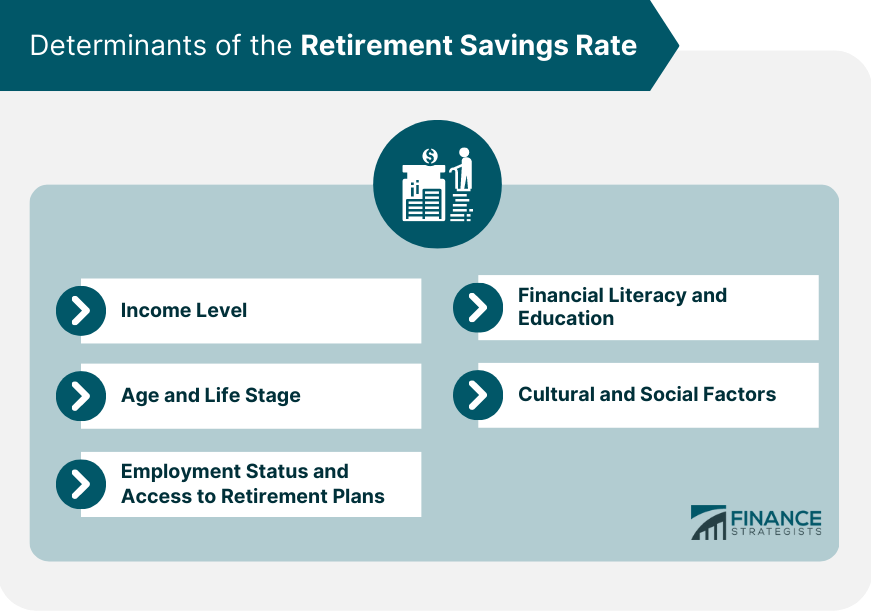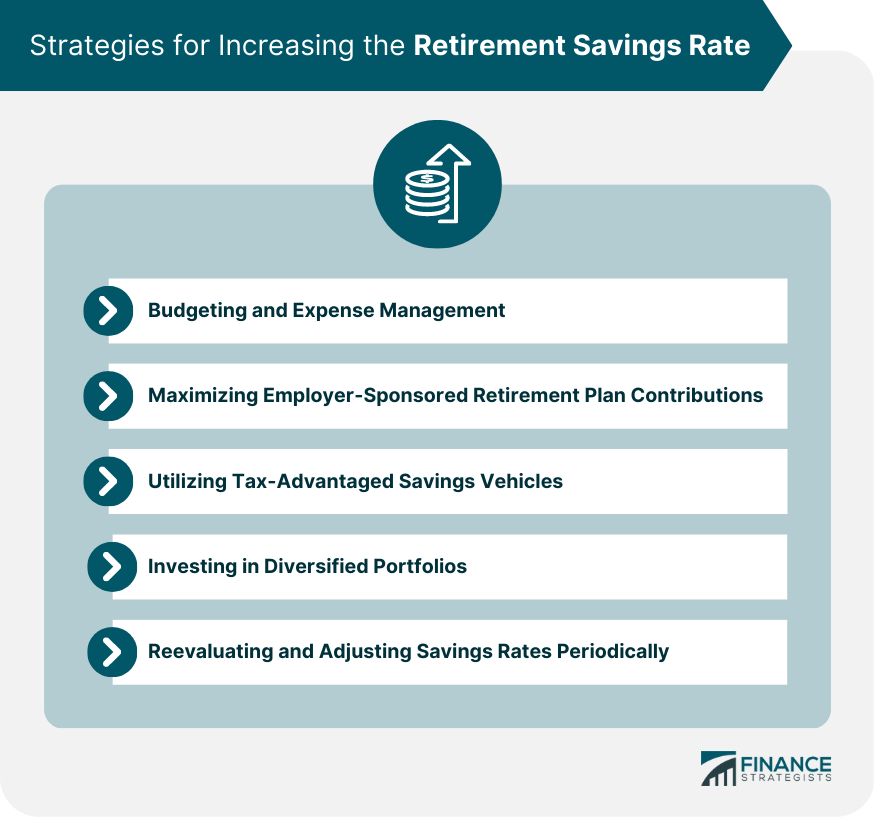The retirement savings rate refers to the percentage of an individual's income that is allocated towards retirement savings, typically through retirement accounts, investments, and other savings vehicles. This rate is crucial in determining the adequacy of an individual's retirement nest egg and their ability to maintain a desired lifestyle during retirement. An appropriate retirement savings rate is essential for achieving financial security and independence in retirement, providing a cushion against unexpected expenses, and ensuring a comfortable standard of living. Various factors, such as income level, age, employment status, financial literacy, and cultural factors, can influence an individual's retirement savings rate. Higher income levels generally correlate with higher retirement savings rates, as individuals with more disposable income can afford to save a larger portion of their earnings for retirement. An individual's age and life stage can significantly impact their retirement savings rate. For example, younger individuals may have lower savings rates due to competing financial priorities, while older individuals approaching retirement may prioritize saving more aggressively. Employment status and access to employer-sponsored retirement plans can also influence retirement savings rates. Individuals with access to such plans may have higher savings rates due to employer contributions and the convenience of automatic deductions from their paychecks. Individuals with greater financial literacy and education tend to have higher retirement savings rates, as they understand the importance of saving for retirement and are more likely to make informed decisions about their financial future. Cultural and social factors, such as societal expectations and family dynamics, can also impact retirement savings rates. In some cultures, individuals may prioritize saving for retirement due to social norms, while in others, a focus on supporting family members may take precedence. Financial experts often recommend saving at least 10-15% of one's income for retirement. However, individual circumstances and goals may necessitate adjustments to these guidelines. Individuals may need to adjust their retirement savings rate based on factors such as their age, income, desired retirement lifestyle, and the age at which they plan to retire. For example, those who start saving later in life or who wish to retire early may need to save a higher percentage of their income. Individuals planning for early retirement should aim for a higher savings rate to ensure they have adequate savings to last throughout their retirement years. Conversely, those who plan to work longer may be able to save at a lower rate, as their retirement savings will have more time to grow. Creating and adhering to a budget can help individuals identify areas where they can reduce expenses and allocate more funds towards retirement savings. Taking full advantage of employer-sponsored retirement plans, such as contributing enough to receive the full employer match, can help increase an individual's retirement savings rate. Contributing to tax-advantaged savings vehicles, such as IRAs or 401(k)s, can help individuals save more for retirement by reducing their tax liability. Investing in diversified portfolios can help individuals grow their retirement savings more effectively, reducing the risk of loss and increasing the potential for returns. Regularly reevaluating and adjusting one's retirement savings rate can help individuals stay on track with their retirement goals. Factors such as income changes, major life events, and shifts in retirement goals may necessitate adjustments to an individual's savings rate. A higher retirement savings rate generally results in a larger nest egg, increasing the likelihood of having sufficient funds to maintain a desired lifestyle during retirement. An adequate retirement savings rate can contribute to a higher quality of life in retirement, as individuals will have more financial resources to cover living expenses, healthcare costs, and leisure activities. Maintaining an appropriate retirement savings rate is essential for achieving financial independence and security in retirement, reducing the reliance on government assistance programs and the need for financial support from family members. A healthy retirement savings rate can also provide a buffer against unexpected expenses and emergencies, ensuring that individuals have the financial resources to address unforeseen challenges during retirement. A suitable retirement savings rate is essential for ensuring financial security and independence during retirement, providing a cushion against unexpected expenses, and maintaining a comfortable standard of living. Understanding the factors that influence retirement savings rates and adopting strategies to increase savings can help individuals achieve their retirement goals. Addressing the challenge of retirement savings rates requires both individual responsibility and collective action. By taking steps to improve their own savings rates and supporting initiatives aimed at promoting financial literacy and access to retirement savings vehicles, individuals, employers, and policymakers can work together to ensure a more secure financial future for all. Ensuring a financially stable future for retirees requires continued efforts, collaboration, and innovation, emphasizing the importance of a collective approach to improving retirement savings rates.What Is the Retirement Savings Rate?
Determinants of the Retirement Savings Rate
Income Level
Age and Life Stage
Employment Status and Access to Retirement Plans
Financial Literacy and Education
Cultural and Social Factors

Recommended Retirement Savings Rates
General Guidelines
Adjustments Based on Age, Income, and Retirement Goals
Considerations for Early or Late Retirement
Strategies for Increasing the Retirement Savings Rate
Budgeting and Expense Management
Maximizing Employer-Sponsored Retirement Plan Contributions
Utilizing Tax-Advantaged Savings Vehicles
Investing in Diversified Portfolios
Reevaluating and Adjusting Savings Rates Periodically

The Impact of the Retirement Savings Rate on Retirement Outcomes
Retirement Savings Adequacy
Quality of Life in Retirement
Financial Independence and Security
Ability to Address Unexpected Expenses and Emergencies
Conclusion
Retirement Savings Rate FAQs
A retirement savings rate refers to the percentage of an individual's income that is contributed to retirement savings accounts such as a 401(k), IRA, or other retirement savings vehicles.
Financial experts generally recommend saving between 10-15% of your income for retirement. However, the appropriate savings rate can depend on factors such as your age, retirement goals, expected expenses, and expected retirement income.
A high retirement savings rate can help individuals accumulate more retirement savings, reduce the risk of running out of money in retirement, and increase the likelihood of achieving retirement goals. It can also provide a greater sense of financial security and peace of mind.
A low retirement savings rate can leave individuals with insufficient retirement savings to support their desired lifestyle in retirement. This can result in having to work longer, delay retirement, reduce expenses, or adjust retirement plans.
Individuals can increase their retirement savings rate by making regular contributions to their retirement savings accounts, increasing their contribution percentage, taking advantage of employer matching contributions, and exploring alternative savings vehicles such as IRAs or annuities. It's important to also consider the impact of fees, taxes, and investment performance when determining an appropriate retirement savings rate.
True Tamplin is a published author, public speaker, CEO of UpDigital, and founder of Finance Strategists.
True is a Certified Educator in Personal Finance (CEPF®), author of The Handy Financial Ratios Guide, a member of the Society for Advancing Business Editing and Writing, contributes to his financial education site, Finance Strategists, and has spoken to various financial communities such as the CFA Institute, as well as university students like his Alma mater, Biola University, where he received a bachelor of science in business and data analytics.
To learn more about True, visit his personal website or view his author profiles on Amazon, Nasdaq and Forbes.











